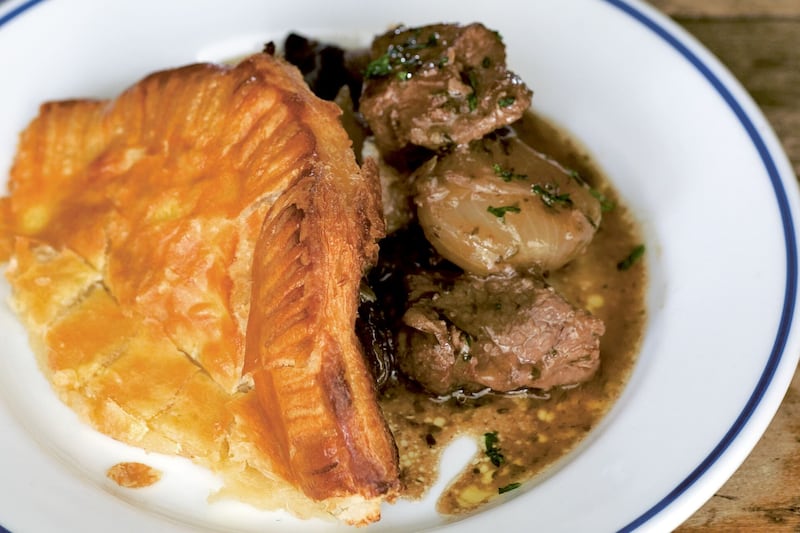MENUS are usually things you quickly scan before discarding, that you spill red wine on, or fold up to stabilise a wobbly table leg. For Co Down-born food writer Diana Henry, though, menus are so much more than that, and not purely the domain of restaurants either.
"At the weekend, I've always got friends calling me asking, 'Di, what can I do for a starter that's really quick?' or they'll have decided on the main course but will say, 'What can I do for a pudding?'
"I'm always telling people what goes with what," she explains. "I love the challenge of standing in the greengrocer's and putting things together."
A resource not just to her friends, the Sunday Telegraph and Waitrose Weekend writer's new cookbook, How To Eat A Peach, combines her love of matching ingredients with planning meals.
"I love putting menus together for no reason whatsoever," Henry says, remembering how she'd jot down food plans as a teenager, filling a 'fantasy' notebook with meals she'd cook in an ideal world.
Brought up in Coleraine and Portstewart in what she has described as a "Protestant but non-unionist" household, Henry began having people round for supper when she was about 16 (her parents had parties, not dinner parties), and the menu planning never ceased: "I do it now still – I think of a menu, and then I think about who would like to eat it."
How To Eat A Peach was inspired, both in title and content, by an evening that the Oxford English graduate spent in Italy, watching a group of Italians slicing white-fleshed peaches and dropping them into glasses of ice cold Moscato, only to drink the liquid and then pick out and eat the soft fruit, sticky and plump with the booze.
"It's such a lovely way to end a meal, but is also a really good approach to cooking," she says. "It's about knowing when not to do anything, and when something is just elegant and lovely in itself."
The book, as a result (with a peachy, softly furred jacket), helps you tread the line between "when to not do very much, and when to do very much". Just don't expect it to be about 'entertaining'...
"I hate that word," says Henry with a grimace. The word "hosting" gets similarly short shrift: "I just have people in."
The collection is woven through with a sense of place, with each chapter grounded by a moment in time, a memory of a place, a season, as well as a single, or set of, ingredients. "Each menu is its own little world," says Henry, flipping through evocatively titled examples like, 'Drunk on olive oil', 'Take me back to Istanbul', and 'Monsieur Matuchet plays the piano'.
"One of the main reasons I cook is to go back to places; or go to places," she explains. Henry, now London-based with two sons of her own, travels a lot (Russia is a current focus), but didn't as one of four children growing up in Co Antrim ("The way I travelled was by reading, and by cooking – I so wanted to go elsewhere, desperately").
"It seems crazy, but in the mid-70s, you couldn't get peppers and aubergines in Northern Ireland – those were exotic," she says, recalling how she wrangled her greengrocer into ordering them specially so she could make ratatouille. "If you've never cooked aubergine before, that melting texture and that taste which is hard to say what it is at all – that was the way I went places."
Aged 15, she finally went abroad for the first time – to France on an exchange trip, where a boy taught her to make perfectly lacy crepes (she still has the recipe written on blue airmail paper and it's recreated in the book, with added sauteed apple and caramel), before years of Easters spent in Normandy and Brittany followed. The memories are stirred intrinsically into chapter one, 'Cider and gitanes', while the time she went to meet a man about a horse in a bar with her father in Spain ("It had these great leather chairs and smoke in the air") defines 'Darkness and light', where squid ink and rice are paired with romesco sauce.
Henry trained at Leiths Cookery School, and formerly worked in TV, but considers herself a home cook ("I don't especially like complicated stuff"), and says she couldn't be a professional chef because she'd grow too bored making the same dishes on repeat.
Instead, she spends her time constantly thinking about combinations, asking herself: "What is good with that? You think about flavour and texture; you think about what you want in your mouth – lots of cooking is about contrast."
Her recipes often develop as ways to solve problems – for instance, what to eat when it's too hot to cook, or, when you're having people over and one of your dishes requires a lot of effort.
"It's about having a little bit of thought." And no-one's food is more thoughtful than Diana Henry's.
:: How To Eat A Peach by Diana Henry, photography by Laura Edwards, is published in hardback by Mitchell Beazley, priced £25 (octopusbooks.co.uk). Below are three recipes from the book for you to try at home.
ASPARAGUS, PEAS AND RADISHES WITH PISTACHIO PESTO
(Serves 6)
For the pesto:
150g shelled unsalted pistachio nuts
8 spring onions, trimmed and chopped
15g unsalted butter
1 fat garlic clove, crushed
170ml extra virgin olive oil
130g ricotta, preferably fresh rather than UHT
40g pecorino or Parmesan cheese, finely grated
Sea salt flakes and freshly ground black pepper
For the vegetables:
8-10 radishes, preferably French breakfast radishes
650g asparagus
3tbsp extra virgin olive oil
3/4tbsp white balsamic vinegar
200G fresh raw peas
25g pea shoots
Method
Start with the pesto. Boil two-thirds of the pistachios in water for four minutes; this softens them and makes the pesto creamy. Drain and dry them in a tea towel. You need to rub off all the papery skin (laborious but therapeutic). Lightly toast the rest of the nuts in a dry pan for about 30 seconds. You will be able to smell the toasted aroma. Immediately transfer to a plate.
Cook the spring onions in the butter in a small saucepan until soft, but not coloured. Add the garlic and cook for another 30 seconds or so. Blitz all the nuts with the spring onions and garlic in a food processor, gradually adding the extra virgin olive oil. Stir in the ricotta and pecorino or Parmesan. Season and taste.
Shave the radishes using a mandoline, or cut them very finely with a sharp knife. Break or cut off the base of each asparagus spear. Bring a pan with about 7.5cm of water to the boil. Stand the asparagus in this, bases in the water, spears leaning against the side (they cook in the steam). Cover with a lid. Cook until only just tender, testing with a point of a knife. (Roughly four-seven minutes depending on thickness.) Lift the asparagus out of the pan, then quickly dry with a clean tea towel.
Add a little of the asparagus cooking water to the pesto to loosen and thin it. Mix the extra virgin olive oil and the white balsamic vinegar together and season. Divide the asparagus, raw peas, radishes and pea shoots between six plates – or put them all on a platter – and drizzle with the white balsamic dressing. Spoon on some of the pesto and offer the rest at the table.
CRAB, TOMATO AND SAFFRON TART
(Serves 6-8)
For the pastry:
250g plain flour, plus more to dust
150g chilled unsalted butter, chopped
Good pinch of sea salt flakes
1 egg yolk
For the filling:
4 plum tomatoes
15g unsalted butter
1/2tbsp regular olive oil
1 small onion, very finely chopped
2 garlic cloves, finely chopped
Sea salt flakes and freshly ground black pepper
Pinch of caster sugar (optional)
Squeeze of lemon juice (optional)
200ml double cream
Generous pinch of saffron threads
100ml creme fraiche
1 large egg, plus 3 egg yolks
200g white crab meat
50g brown crab meat
Method
To make the pastry, put the flour, butter and salt into a food processor and whizz until the mixture resembles breadcrumbs. Mix the yolk with half a tablespoon of very cold water, add it and whizz again. The pastry should come together into a ball. Wrap it in cling film and allow to rest in the fridge for 20 minutes, then roll out on a lightly floured surface and use to line a 23cm loose-bottomed tart tin. Prick the bottom with a fork, then chill in the fridge or freezer until cold and firm.
Preheat the oven to 180°C/gas mark 4 and put in a metal baking sheet to heat up. Line the pastry with greaseproof paper and fill with baking beans. Bake the pastry case, on the hot baking sheet, for 14 minutes, removing the paper and beans after seven. Leave to cool.
Plunge the tomatoes into boiling water and leave for 20 seconds, then remove. Skin, halve, deseed and cut the flesh into slivers. Heat the butter and regular olive oil in a frying pan and cook the onion and tomatoes gently until soft but not coloured. Add the garlic, season and continue to cook until you have a thick puree. Taste. If the tomatoes didn't have the best flavour to begin with, it will benefit from the tiniest bit of sugar and a squeeze of lemon juice. The puree should be dry, not at all wet. Spoon it into the pastry case.
Put about 50ml of the double cream in a saucepan and add the saffron threads. Heat until just under boiling, then stir until you can see the saffron colouring the cream. Leave to cool. Mix this with the rest of the double cream, the creme fraiche, egg and egg yolks. Season well and gently stir in all the crab. Slowly pour into the tart case.
Return the tart to the hot baking sheet and cook for 45 minutes, or until the pastry is golden and the filling just set in the middle (it should still have a little give, as it will continue to cook out of the oven).
Leave to cool for 15 minutes, then remove the tart tin and serve with a green salad, or green beans with toasted almonds.
GOOSEBERRY AND ALMOND CAKE WITH LEMON THYME SYRUP
(Serves 6-8)
For the cake:
125g unsalted butter, softened, plus more for the tin
125g caster sugar, plus 5tbsp extra
3 large eggs, at room temperature, lightly beaten
75g plain flour, sifted
2tsp chopped lemon thyme leaves
Finely grated zest of 1 unwaxed lemon
75g ground almonds (preferably freshly ground)
3/4tsp baking powder
350g gooseberries, topped and tailed
For the syrup:
4tbsp granulated sugar
Juice of 2 large lemons
2tsp lemon thyme leaves
For the poached gooseberries (optional):
75g granulated sugar
2 lemon thyme sprigs
500g gooseberries, topped and tailed
To serve:
Thyme flowers, if you can find any
Icing sugar, to dust (optional)
Sweetened creme fraiche, or whipped cream
Method
Preheat the oven to 190°C/375°F/gas mark 5. Butter a 20cm springform cake tin and line the base with baking parchment.
Beat the butter and the 125g of caster sugar until pale and fluffy. Add the eggs a little at a time, beating well after each addition. If the mixture starts to curdle, add one tablespoon of the flour. Put the lemon thyme leaves in a mortar with the lemon zest and pound together to release the fragrance. Add to the batter and briefly mix.
Fold in the rest of the flour, the almonds and the baking powder, using a large metal spoon. Scrape into the tin. Toss the gooseberries with the remaining five tablespoons of caster sugar and spread over the top. Bake for 30 minutes. The cake is ready when a skewer inserted into the centre comes out clean.
To make the syrup, quickly heat the granulated sugar, lemon juice and lemon thyme leaves in a saucepan, stirring to help the sugar dissolve. Pierce the cake all over with a skewer while it is still warm and slowly pour the syrup into it. Leave to cool a little, then carefully remove from the tin and put on a serving plate.
Meanwhile, make the poached gooseberries. Heat 175ml of water, the granulated sugar and lemon thyme together in a saucepan, stirring until the sugar has dissolved. Add the gooseberries and cook over a medium heat for four minutes, or until the fruit is soft but not collapsing (most of the berries should still hold their shape). Leave to cool.
Any thyme flowers you have will look lovely on top of the cake. You can leave it as it is, or dust lightly with icing sugar just before serving, with sweetened creme fraiche or whipped cream and the poached gooseberries on the side.








